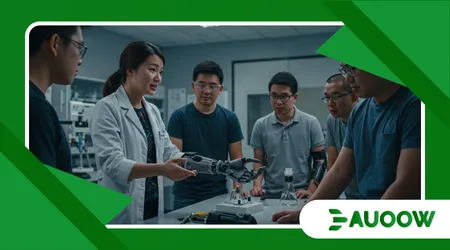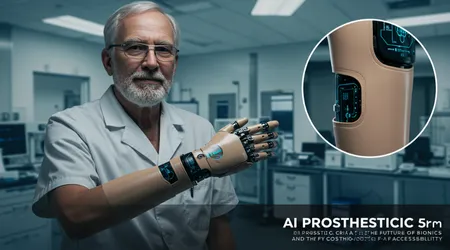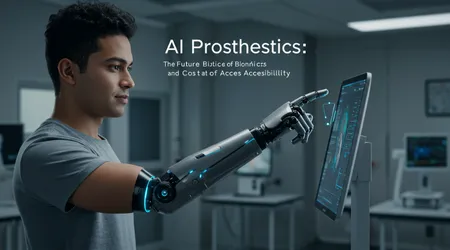AI Prosthetics: The Future of Bionics and the Cost of Accessibility

AI Prosthetics are revolutionizing mobility and independence for millions, blending cutting-edge technology with human resilience.
In 2025, these devices powered by artificial intelligence offer unprecedented functionality, mimicking natural limb movements with remarkable precision.
From bionic arms that interpret neural signals to smart exoskeletons aiding paralyzed individuals, the promise of AI Prosthetics is transformative.
Yet, a critical question looms: can accessibility keep pace with innovation? This article explores the advancements, challenges, and ethical considerations of AI Prosthetics, delving into their potential to redefine lives while addressing the steep costs that limit their reach.
With the assistive technology market projected to hit $37 billion by 2033, the stakes are high for inclusivity and equity.
The journey of AI Prosthetics begins with understanding their profound impact. These devices go beyond mechanical replacements, integrating AI to adapt to users’ unique needs.
By analyzing vast datasets, AI enables prosthetics to anticipate movements, offering a fluid, natural experience. Imagine a world where losing a limb doesn’t mean losing freedom AI Prosthetics are making this a reality.
However, their high costs and complex development raise questions about who can access these life-changing tools. This exploration uncovers the balance between technological breakthroughs and the human right to mobility.
The Evolution of AI-Driven Bionics
Advancements in AI Prosthetics have redefined rehabilitation, merging neuroscience, robotics, and machine learning. Devices like the LUKE Arm, developed by DEKA, use AI to enable complex movements, allowing users to grasp objects with precision.
Neural interfaces interpret brain signals, mimicking natural limb functions. This synergy of technology and biology empowers amputees to reclaim independence, from tying shoelaces to playing musical instruments.
Consider Sarah, a fictional violinist who lost her arm in an accident. With an AI-powered bionic hand, she retrains her brain to control precise finger movements, resuming her passion.
++ How AI-Powered Wheelchairs Are Transforming Mobility in 2025
Such stories highlight the potential of AI Prosthetics to restore not just function but identity. Yet, the sophistication of these devices demands extensive research, driving up costs that many cannot afford.
The evolution doesn’t stop at upper limbs. Lower-limb prosthetics, like Össur’s Proprio Foot, adjust in real-time to terrain, ensuring natural gait.
AI analyzes walking patterns, reducing physical strain. This adaptability transforms lives, but development costs often millions create barriers, leaving many without access to these innovations.

The Technology Behind AI Prosthetics
At the heart of AI Prosthetics lies machine learning, enabling devices to learn from users’ movements. Neural networks process electromyography (EMG) signals from muscles, translating them into actions.
This creates a seamless brain-to-prosthetic connection, akin to a conductor guiding an orchestra. The result? Prosthetics that feel like extensions of the body, not foreign objects.
Brain-computer interfaces (BCIs) push boundaries further. By decoding neural signals, BCIs allow thought-controlled prosthetics, as seen in research from Johns Hopkins University.
These advancements promise unparalleled control but require sophisticated algorithms and sensors, escalating production costs. Accessibility hinges on simplifying these technologies without sacrificing quality.
Also read: Is Your Website Accessible? Free Tools That Actually Work
Moreover, 3D printing has emerged as a game-changer. It lowers costs for custom prosthetics, as seen in initiatives like e-NABLE, which creates affordable bionic hands.
Yet, even 3D-printed AI Prosthetics struggle to reach low-income communities, where access to skilled technicians remains limited.
The Cost Barrier: Accessibility vs. Innovation
The financial hurdle of AI Prosthetics is stark. A single advanced bionic arm can cost $15,500, as seen with the FDA-approved model used by retired Sergeant Garrett Anderson.
While Medicare may cover some costs, many lack adequate insurance. This creates a divide where only the affluent benefit from cutting-edge technology.
Globally, the issue intensifies. The World Health Organization estimates 2.5 billion people need assistive products, a number expected to rise to 3.5 billion by 2050.
In low-resource settings, even basic prosthetics are scarce. AI Prosthetics, with their high development costs, remain out of reach for most, perpetuating inequality.
Read more: Reviewing the Top 5 Screen Readers of 2025: Speed, Accuracy and U
Innovations like AgiBot’s OmniHand 2025, priced under 10,000 RMB ($1,400), aim to disrupt this.
By prioritizing affordability, such models challenge the status quo. However, scaling these solutions requires investment in infrastructure, training, and policy reform to ensure equitable distribution.
| Cost Comparison of AI Prosthetics (2025) | Price Range (USD) | Features | Accessibility |
|---|---|---|---|
| LUKE Arm | $50,000 – $80,000 | Neural control, multi-task dexterity | Limited, high-end |
| Össur Proprio Foot | $20,000 – $40,000 | Terrain adaptation, AI gait analysis | Moderate, insured |
| AgiBot OmniHand Agile | $1,400 – $2,000 | 16 DOF, affordable design | Broad, emerging markets |
Ethical Considerations in AI Prosthetics
The rise of AI Prosthetics sparks ethical debates. Privacy is a key concern, as these devices collect sensitive neural and biometric data.
Without robust encryption, users risk data breaches, undermining trust. Ethical AI design must prioritize user autonomy and security, ensuring data isn’t exploited.
Bias in AI algorithms also poses risks. If training data lacks diversity, prosthetics may underperform for certain demographics, exacerbating disparities.
Developers must adopt inclusive datasets, reflecting varied ages, genders, and ethnicities to ensure universal efficacy.
Moreover, the psychological impact of AI Prosthetics demands attention. Users like Sarah may face identity struggles, adapting to a bionic limb.
Support systems, including counseling, are crucial to help users embrace their enhanced capabilities without losing their sense of self.
The Future of AI Prosthetics: Bridging the Gap
What will it take to make AI Prosthetics universally accessible? Governments and NGOs must collaborate to subsidize costs, as seen in initiatives like the European Disability Forum’s advocacy for equitable access.
Policies promoting insurance coverage and public funding can bridge gaps, ensuring no one is left behind.
Emerging technologies, like reinforcement learning, promise smarter prosthetics. Posts on X highlight robots achieving superhuman walking via AI training, hinting at future prosthetic advancements.
Such innovations could lower costs by streamlining production, making AI Prosthetics more scalable.
Community-driven solutions also hold potential. Open-source platforms like e-NABLE empower volunteers to create affordable prosthetics.
By integrating AI, these initiatives could produce low-cost, high-function devices, democratizing access and fostering global inclusion.
Real-World Impact: Stories of Transformation
Consider James, a fictional carpenter who lost his leg in a work accident. With an AI-powered prosthetic knee, he resumes his craft, adjusting to uneven workshop terrain.
His story mirrors real-world cases where AI Prosthetics restore livelihoods, boosting confidence and economic independence.
Beyond physical benefits, these devices enhance social inclusion. A 2023 survey found 87% of assistive technology users want to provide feedback to developers, signaling a desire for user-driven innovation. Engaging communities ensures prosthetics meet diverse needs, amplifying their impact.
The ripple effect extends to education and employment. AI-driven exoskeletons enable students with mobility issues to navigate campuses, while workers regain job capabilities.
These advancements underscore the transformative power of AI Prosthetics, but only if accessible to all.
Overcoming Challenges: A Call to Action

High development costs remain a hurdle. Creating AI Prosthetics involves years of research, from neural interface design to algorithm training.
Streamlining these processes through public-private partnerships could reduce expenses, making devices more affordable.
Regulatory barriers also slow progress. Standardizing safety protocols for AI-driven devices, as advocated by the National Institute of Child Health, can accelerate approvals without compromising quality. Faster approvals mean quicker access for users.
Finally, awareness is key. Many potential users, especially in rural areas, lack knowledge of AI Prosthetics. Outreach campaigns, leveraging platforms like X, can educate communities, connecting them with resources and funding opportunities.
Conclusion: A Vision for Inclusive Innovation
The future of AI Prosthetics is a tapestry of hope and challenge, woven with threads of innovation and equity.
These devices, blending AI with human resilience, promise to redefine mobility and independence. Yet, their high costs and complex development risk leaving millions behind.
By prioritizing affordability, ethical design, and global collaboration, we can ensure AI Prosthetics become a universal right, not a privilege.
The question isn’t whether we can build a bionic future it’s whether we can make it accessible to all. Let’s commit to a world where technology uplifts every individual, regardless of circumstance, creating a legacy of inclusion.
Frequently Asked Questions
Q: How do AI Prosthetics differ from traditional prosthetics?
A: AI Prosthetics use machine learning to adapt to users’ movements, offering natural control via neural signals, unlike static traditional prosthetics.
Q: Are AI Prosthetics covered by insurance?
A: Coverage varies. Some, like the LUKE Arm, may be partially covered by Medicare, but many users face high out-of-pocket costs.
Q: What are the main barriers to accessing AI Prosthetics?
A: High costs, limited insurance, and lack of infrastructure in low-resource areas restrict access, alongside regulatory and awareness challenges.
Q: Can AI Prosthetics be customized for individual needs?
A: Yes, AI enables personalization by learning users’ movement patterns, ensuring devices align with unique physical and lifestyle needs.
Q: What ethical concerns arise with AI Prosthetics?
A: Privacy risks from data collection, algorithmic bias, and psychological impacts of adaptation highlight the need for ethical, inclusive design.
